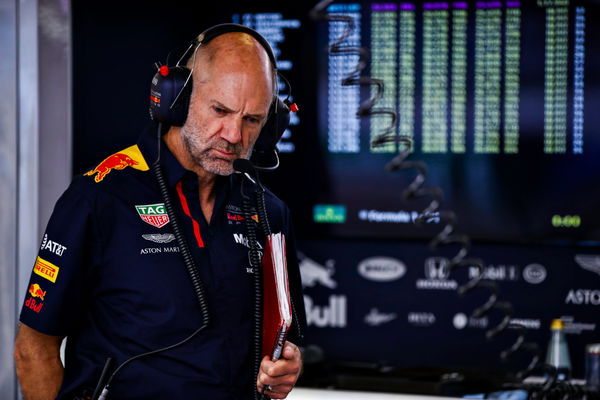
via Getty
PORTIMAO, PORTUGAL – OCTOBER 23: Adrian Newey, the Chief Technical Officer of Red Bull Racing looks on in the garage during practice ahead of the F1 Grand Prix of Portugal at Autodromo Internacional do Algarve on October 23, 2020 in Portimao, Portugal. (Photo by Mark Thompson/Getty Images)

via Getty
PORTIMAO, PORTUGAL – OCTOBER 23: Adrian Newey, the Chief Technical Officer of Red Bull Racing looks on in the garage during practice ahead of the F1 Grand Prix of Portugal at Autodromo Internacional do Algarve on October 23, 2020 in Portimao, Portugal. (Photo by Mark Thompson/Getty Images)
“I must admit, I personally enjoy regulation changes” – That’s what Red Bull’s Chief Technical Officer, Adrian Newey, told a while back. And why wouldn’t he? He has designed extremely successful cars in many eras of the sport since 1992. The current Red Bull cars are the perfect example of his success. However, he has recently expressed concerns over the next Formula 1 regulation change that will take effect in 2026.
Red Bull has been utterly dominant in the current ground effect era, thanks in part to the brilliance of Adrian Newey, but also because of the Honda Power Units at the back of its car. However, the Honda-Red Bull partnership is coming to an end in 2025 with Ford entering the picture to help the Milton Keynes squad develop its own Power Units under the Red Bull Powertrains wing. But Adrian Newey is not fully comfortable with the 2026 engine regulations despite massive backing from Ford.
One of the biggest reasons behind Newey’s concerns is the fact that the team will not only have to work on a brand new power unit, which will have a 50-50 power split between the ICE and the battery but also because there is a massive change in the aerodynamic regulations with the controversial ‘active-aero’ tech coming into the sport.
ADVERTISEMENT
Article continues below this ad
Newey believes that it will be extremely difficult for the teams to get both changes right at the same time. “With regard to the ’26 regulations, we don’t have them yet. It’s the first time I can remember where both the chassis regulations and the power unit regulations are changed at the same time. It’s a massive change,“ said Newey.
While he may be confident about getting the aerodynamics part of the regulation right, he feels that the new engine regulations don’t make much sense. “The problem at the moment is trying to get the chassis regulations to work well with, let’s say, a rather unusual power unit regulation,” he added.
Adrian Newey says Red Bull is struggling to find gains in the current regulations
"In our case, we’re struggling to find the gains, if you like, in terms of aero gains in percent per month, or whatever, are flattening, without doubt."
[@Racingnews365 / https://t.co/FClasPIF2O] pic.twitter.com/nfhTxqLpMS
— RBR Daily (@RBR_Daily) April 15, 2024
But what is it exactly that Newey finds so unusual about the new Power Unit Regulations?
Adrian Newey explains the strange way power units will behave in 2026
Formula 1 is on its way to becoming carbon neutral by 2030 and the new power units are a step in that direction. The 2026 cars will not only use synthetic fuels, but they will also reduce the amount of power delivered by the internal combustion engine (a 50-50 split between ICE and the battery). However, according to Adrian Newey, this shift in power ratio presents a unique challenge as it focuses too much on power recovery.
He used the example of the Monaco Loews hairpin turn to explain his point. “It’s certainly going to be a strange formula in as much as the engines will be working flat-chat as generators just about the whole time,” said Newey. “So, the prospect of the engine working hard in the middle of Loews hairpin is going to take some getting used to.”
ADVERTISEMENT
Article continues below this ad
📰: Adrian Newey believes Formula 1’s 2026 rules will introduce unique challenges due to the “strange” behavior of power units, which will act as generators most of the time. This shift in engine dynamics, with a focus on energy recovery, may require engines to run at full revs… pic.twitter.com/Kb9wsWJkGj
— F1 Naija (@f1_naija) April 14, 2024
Another major concern for Newey is that the teams will have to design the aerodynamics in a way that complements the engine specifications. He added, “It is fair to say that the engine regulations were created and pushed through without very much thought to the chassis side of it, and that is now creating quite large problems in terms of trying to come up with a solution to work with it.”
ADVERTISEMENT
Article continues below this ad
Creating an ‘active-aero’ package that will work well with the engine’s behavior might seem like a daunting task. But it is all being done for the sport to become more sustainable in the future. And that is the only silver lining as far as Adrian Newey is concerned.
Will the new regulations make the racing worse or better? Share your thoughts on the matter.
ADVERTISEMENT
ADVERTISEMENT
ADVERTISEMENT
ADVERTISEMENT

